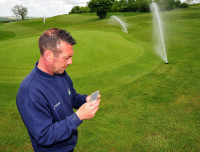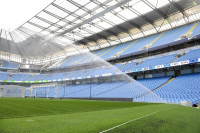Promoting optimum grass growth

With various summer sports in full swing, and golf's high season at its peak, it is vital groundsmen and greenkeepers alike have a good handle on, and understanding of, their turf's irrigation needs.
And, with the majority of football and rugby pitches renovated and ready for the new season, preparing the pitch for maintenance work such as aeration and fertiliser application, maintaining healthy grass growth, facilitating a level of impact absorbency and germinating seed, now is a good time for club groundsmen to start thinking about, and indeed planning, pitch management improvements for the upcoming 2016/17 season.
All geared towards promoting optimum grass growth, balanced soil moisture levels and water efficiency, the following advice from Robert stems from over twenty years experience in the irrigation business, having been involved in both contracting and creating irrigation design specifications for sports and golf course installations.
Monitor your soil's moisture levels

Many groundsmen and greenkeepers still rely on a combination of experience and on site weather data to determine irrigation requirements.
However, the only way to accurately measure soil moisture content and avoid over-irrigating is to utilise technology.
Systems that feature soil monitoring technology are fantastic for making better decisions and saving money. Whether using a hand-held sensor to perform regular spot checks or an irrigation system with sensors in the ground to do it for you, precise measurements on soil moisture and temperature of the playing surface provide invaluable data. And knowledge, as we all know, is power, allowing irrigation decisions to be made to avoid over-watering and detecting dry areas before the turf's health is impacted, and making the job of improving soil and turf health and reducing water usage almost effortless.
Take and compare multiple moisture and temperature readings
Routinely monitoring the moisture content and temperature of the rootzone will not only ensure healthy turf, but it will ensure that you are only watering when necessary. Taking multiple readings over time and at different times - such as before and after irrigation, rainfall, a frost, and on cold days and hot days - also allows you to put any one reading into context and understand how environmental factors influence those readings. Once you are able to determine your turf's normal range and variability, you'll be able to recognise changes due to potential problems. These can be identified before they develop too far, such as disease. Any early identification of problems saves both the cost and time associated with fixative measures.
Choose flexible sprinkler heads

Trajectory options also help fight the wind, avoid obstacles and allow you to reduce the radius quickly, whilst those with easy access to all the critical components will also cut sprinkler maintenance from hours to minutes, and save unsightly turf repair scars.
I would also recommend opting for 'forwards compatible' sprinklers, so that enhancing the sprinkler with new and improved, or redesigned or upgraded systems and replacement parts over time is not only possible, but easy, quick and economical. Some are also backwards compatible too for retrofit installs. Having that level of flexibility saves money in the long term.
Use water as efficiently as possible

Aside from the importance of protecting our valuable water resources, applying water efficiently - using both knowledge and innovative irrigation technology - saves money and improves growing conditions. Reiterating previous points, having a fully functional control system will ensure only the required amount of water is being applied, whilst the information that can be taken from a soil monitoring system will also cut back on over watering.
Sprinklers are also key contributors to water use reduction. As irrigation control systems have advanced over the years, so have the sprinklers they control. Use sprinklers that have nozzle options and adjustment capabilities to apply water precisely where it is needed. By simply upgrading older sprinklers to today's models, you can significantly reduce water use, without affecting play.

And finally, have your irrigation assessed to identify areas for improvement
I'll finish by saying that I'd highly recommend having your irrigation system assessed by a third party, especially if it hasn't been done for a while.
